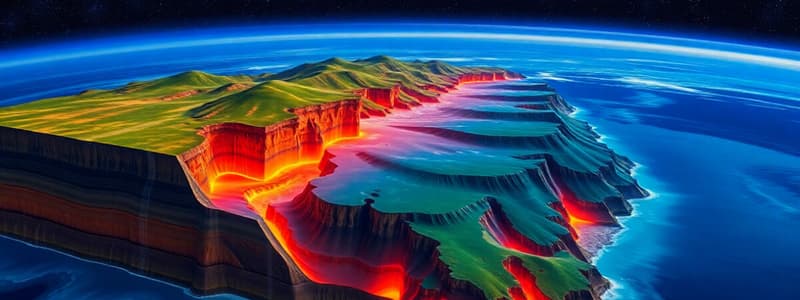Podcast
Questions and Answers
Which of the following textural terms can refer to a lava rock specimen?
Which of the following textural terms can refer to a lava rock specimen?
- Foliation
- Flow banding (correct)
- Bedding
- None of the above
Partial melting is caused by mantle peridotite crossing its liquidus to form a basaltic liquid.
Partial melting is caused by mantle peridotite crossing its liquidus to form a basaltic liquid.
True (A)
Partial melting of mantle peridotite leaves a solid refractory residue of:
Partial melting of mantle peridotite leaves a solid refractory residue of:
- Lherzolite
- Gabbro
- Harzburgite (correct)
- Dunitite
Volcanic glass represents magma's major-element composition:
Volcanic glass represents magma's major-element composition:
Partial melting in intraplate settings can occur by adiabatic decompression because:
Partial melting in intraplate settings can occur by adiabatic decompression because:
Flashcards are hidden until you start studying
Study Notes
Plate Tectonics and Island Arc Magmas
- Island arc magmas are generated in subduction zones where oceanic plates descend beneath continental or oceanic plates.
- The process of subduction causes the release of fluids and melts from the descending slab, which ascend into the overlying mantle wedge.
- The source materials for island arc magmas are primarily derived from the mantle wedge, with contributions from the subducted oceanic plate.
- Melting mechanisms in island arc settings are predominantly driven by the addition of water and other volatiles, which lower the solidus temperature of the mantle wedge.
- Partial melting of the mantle wedge generates a range of magmas, from basaltic to andesitic and even rhyolitic compositions.
- The specific compositions of island arc magmas are influenced by the age and composition of the subducted plate, the depth of subduction, and the rate of convergence.
- Petrographic and geochemical data, such as mineral assemblages, major and trace element concentrations, and isotopic ratios, provide insights into the evolution and processes involved in island arc magmatism.
Calc-Alkaline Magma Differentiation in Island and Continental Arcs
- Calc-alkaline magmas are a common type of magmatism found in both island and continental arcs.
- Differentiation processes, including fractional crystallization, assimilation, and magma mixing, play a significant role in shaping the compositional diversity of calc-alkaline magmas.
- In island arcs, calc-alkaline magmas are typically more primitive and mafic in composition compared to their continental arc counterparts.
- Fractional crystallization is a key process in both island and continental arcs, where minerals crystallize from the magma, leaving behind a more evolved melt.
- The specific mineral assemblages that crystallize depend on the pressure, temperature, and composition of the magma.
- Fractional crystallization results in the removal of incompatible elements from the magma, leading to enrichments in elements such as potassium, rubidium, and cesium.
- In continental arcs, calc-alkaline magmas can be further influenced by crustal assimilation, where the magma interacts with and partially melts the surrounding crust, adding a continental signature to the magma.
- Petrographic and geochemical data, such as mineral compositions, element abundance patterns, and isotopic ratios, provide evidence for the different stages of magma differentiation in island and continental arcs.
Fractional Crystallization and Hawaiian Rock Suite
- The Hawaiian rock suite provides an example of fractional crystallization in a volcanic setting.
- The compositional changes observed in the suite suggest that the magma has undergone a series of fractional crystallization events.
- The initial magma (A) is likely to have been a basaltic melt, based on its major element composition.
- As the magma cools and crystallizes minerals, its composition changes, resulting in the evolution of the magma from A to C.
- Examining the chemical variation diagrams, it suggest that the primary mineral phases that fractionated are olivine, clinopyroxene, and plagioclase.
Formation of Alkaline vs. Subalkaline Magmas
- The formation of alkaline and subalkaline magmas depends on the conditions of partial melting in the mantle.
- Alkaline magmas are typically formed under conditions of higher degrees of partial melting and in environments where the mantle source is rich in incompatible elements.
- Subalkaline magmas are typically formed under conditions of lower degrees of partial melting and in environments where the mantle source is depleted in incompatible elements.
- The conditions of partial melting are influenced by the depth, pressure, and temperature of the mantle source.
- Decompression melting, where the mantle source undergoes pressure release due to upwelling, is a common mechanism for generating both alkaline and subalkaline magmas.
Petrographic Characteristics and Geochemical Signatures
- Alkaline basalts are typically characterized by higher concentrations of alkalis (Na2O and K2O), incompatible elements (e.g., Sr, Ba, Rb), and higher Mg#.
- Subalkaline basalts are typically characterized by lower concentrations of alkalis, lower contents of incompatible elements, and lower Mg#.
- Isotope data can also be used to distinguish alkaline and subalkaline basalts.
- Alkaline basalts often have higher ratios of Sr-87/Sr-86 and Nd-143/Nd-144, indicating that they have originated from a source that has been enriched in radiogenic isotopes.
- Subalkaline basalts typically have lower ratios of Sr-87/Sr-86 and Nd-143/Nd-144, suggesting a source that has been depleted in radiogenic isotopes.
Plume Formation and Volcanic Eruption Dynamics
- Volcanic eruptions are driven by the release of pressure from a rising magma column.
- The rapid expansion of gases within the magma creates a plume, which is a column of hot gas, ash, and rock fragments.
- The height and stability of the plume are influenced by several factors:
- The eruptive velocity of the magma
- The volume and density of the erupted material
- The atmospheric conditions, such as wind speed and direction
- The presence of a pre-existing vent system
- The overall morphology of the volcano
Magma Transport and Eruption
- Magma rises through the crust due to its buoyancy, which is driven by the density difference between the magma and the surrounding rocks.
- The ascent of magma can be influenced by several factors, including:
- The viscosity of the magma
- The presence of pre-existing fractures or faults
- The presence of volatile components, such as water vapor
- The stress field within the crust
- When magma reaches a shallow depth, it can be intruded as sills, which are planar tabular bodies that lie parallel to the bedding of the surrounding rocks.
- Alternatively, if the pressure of the magma exceeds the strength of the overlying rocks, it can erupt at the surface forming a volcano.
Igneous Rocks in Island Arcs and Continental Arcs
- The petrogenesis of igneous rocks in island and continental arcs is influenced by the tectonic setting and the source materials.
- Island arc magmas are typically generated by partial melting of the mantle wedge above the subduction zone.
- They are often enriched in volatiles and have a more mafic composition than continental arc magmas
- Continental arc magmas are typically generated by partial melting of both the mantle wedge and the continental crust.
- They are generally more evolved and have a more silicic composition than island arc magmas
- The differences in composition and petrogenesis of island arc and continental arc magmas can be seen in their major and trace element compositions, isotopic ratios, and mineral assemblages.
Alkaline vs. Subalkaline Basalts in Intraplate Settings
- Partial melting within intraplate settings can occur via adiabatic decompression due to mantle upwelling, or by the presence of hot spots.
- Alkaline basalts are generated under conditions of higher degrees of partial melting and in environments where the mantle source is enriched in incompatible elements. The higher degree of partial melt is caused by mantle material ascending to shallower depths.
- Subalkaline (tholeiitic) basalts are typically formed under conditions of lower degrees of partial melting, caused by shallower partial melt depths, and in environments where the mantle source has been depleted in incompatible elements.
Submarine and Subglacial Eruptions
- Submarine eruptions occur underwater and are characterized by rapid quenching and cooling of the magma.
- Subglacial eruptions occur beneath glaciers or ice sheets and are characterized by the rapid melting of ice.
- Similarities include the rapid cooling of the magma with the formation of pillow basalts and hyaloclastites.
- Differences include the production of volcanic breccias in subglacial eruptions, which are not typically seen in submarine eruptions.
Magma Transport and Intrusions: Silicic and Mafic
- Both silicic and mafic magmas can be transported through the crust.
- The primary driving force for magma transport is buoyancy, which is a result of the density difference between the magma and the surrounding rocks.
- The viscosity of the magma plays a key role in determining how it moves through the crust.
- Silicic magmas are more viscous than mafic magmas, so they move more slowly and are more prone to crystallizing and solidifying before reaching the surface.
- Mafic magmas are less viscous and can move more rapidly, so they are more likely to erupt and form volcanoes.
- The location of these eruptions can be determined by factors such as the geological stress field, the rheology of the crust and the presence of fractures or faults.
Pyroclastic Density Currents
- Pyroclastic density currents are fast-moving flows of hot gas, ash, and volcanic debris that can travel at speeds of hundreds of kilometers per hour.
- They are typically generated during explosive volcanic eruptions, when large volumes of volcanic material are ejected into the atmosphere.
- Pyroclastic density currents can be classified into several types, depending on their origin and characteristics.
- Base surges are low-lying, highly turbulent flows that are characterized by their low velocity but high temperature.
- Ash flows are denser flows of hot gas and ash that can travel relatively long distances.
- They can be extremely destructive and can bury entire towns and cities.
- Pyroclastic density currents can have significant impacts on the environment and human populations.
Rb/Sr and Sm/Nd Isotopes - Compatibility and Earths Interior
- The isotopes of rubidium (Rb) and strontium (Sr) and samarium (Sm) and neodymium (Nd) are used to understand the evolution of magmas and the geochemistry of Earth.
- The compatibility of these isotopes influences the isotopic ratios in the mantle and crust.
- Rubidium is an incompatible element: it is preferentially incorporated into the melt during partial melting.
- Strontium is a moderately compatible element.
- Samarium is a highly compatible element, partitioning better in the solid phase during melting.
- Neodymium is a moderately compatible element
- The ratios of Rb-87/Sr-86 and Sm-147/Nd-144 have been used to study the evolution of the Earth's mantle, crust, and the origin of oceanic island basalts.
- The range of isotopic compositions seen in oceanic island basalts (OIBs) has provided evidence for the existence of a deep mantle reservoir that is distinct from the upper mantle.
- These studies provide valuable insights into the geochemistry of Earth's interior, the processes of mantle evolution, and the formation of magmas.
Studying That Suits You
Use AI to generate personalized quizzes and flashcards to suit your learning preferences.




